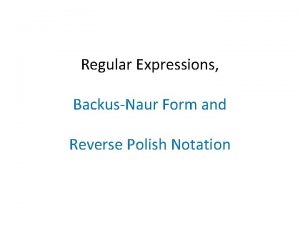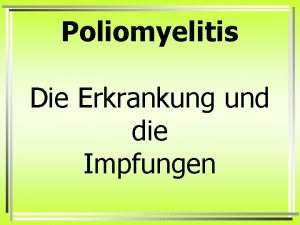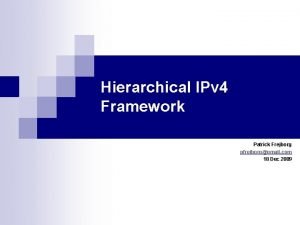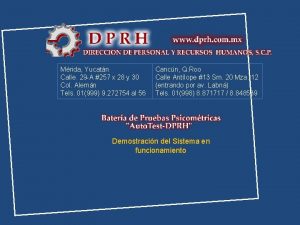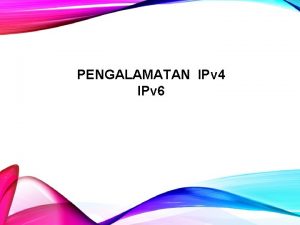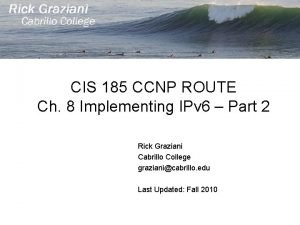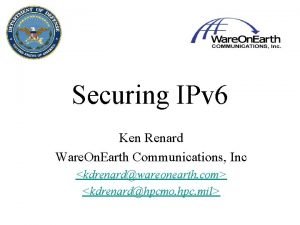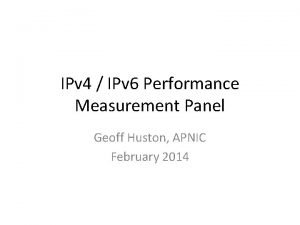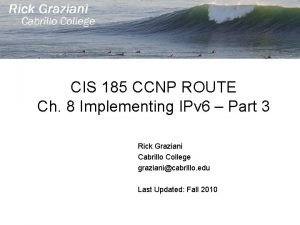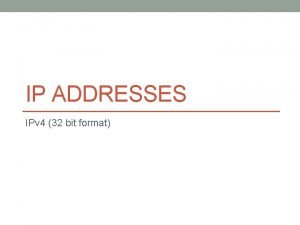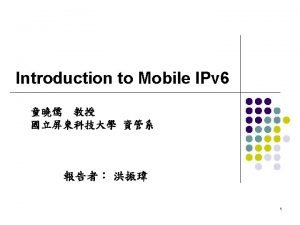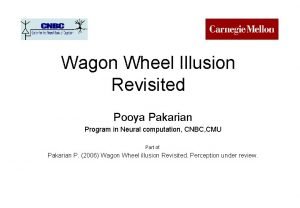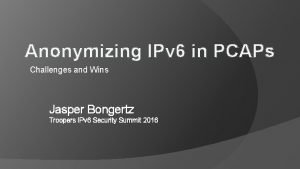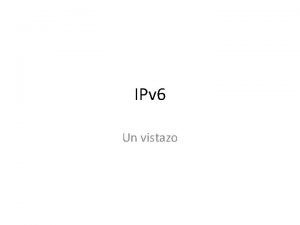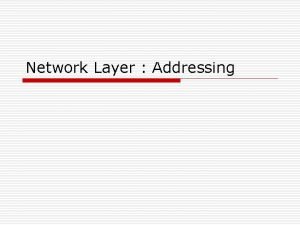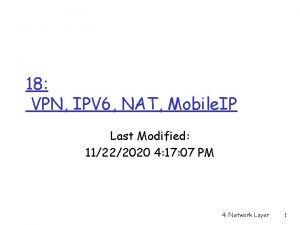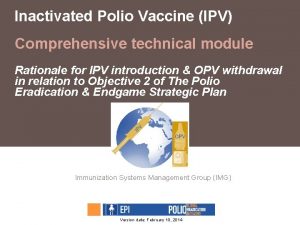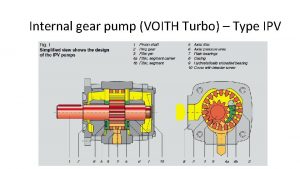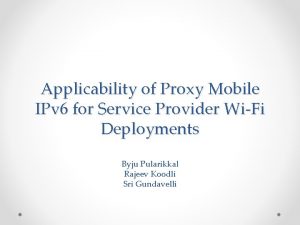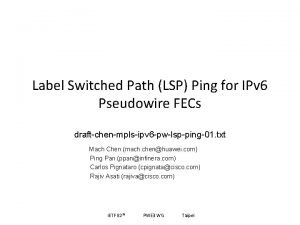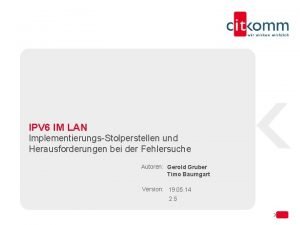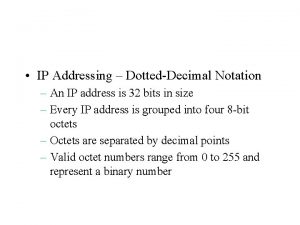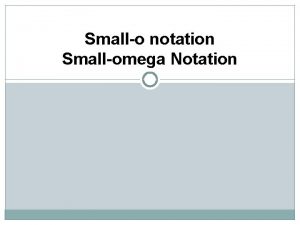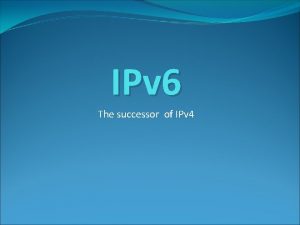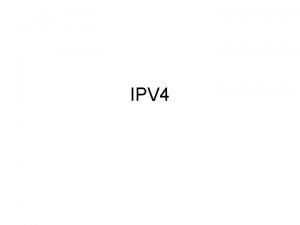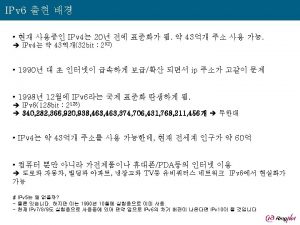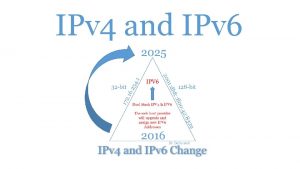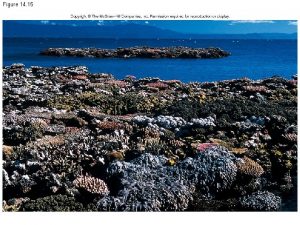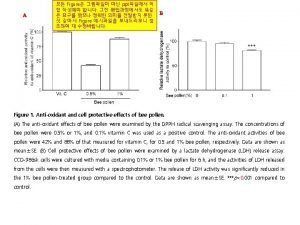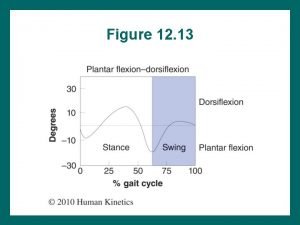IPv 4 Dotteddecimal notation Figure 4 6 Netid




































- Slides: 36




IPv 4地址 Dotted-decimal notation




Figure 4 -6 网络地址Netid and 主机地址hostid




Figure 4 -10 子网掩码

缺省子网掩码 • Class A default mask is 255. 0. 0. 0 • Class B default mask is 255. 0. 0 • Class C Default mask 255. 0

Figure 5 -3 Addresses in a network with and without subnetting

Figure 5 -5 Default mask and subnet mask

Figure 5 -5

Figure 5 -10 Variable-length subnetting

Figure 5 -14 CIDR 表示

Example A small organization is given a block with the beginning address and the prefix length 205. 16. 37. 24/29 (in CIDR notation). What is the range of the block?

Solution • The we keep the first 29 bits and change the last 3 bits to 1 s. • Beginning: 11001111 00010000 00100101 00011000 • Ending : 11001111 00010000 00100101 00011111 • There are only 8 addresses in this block.

Example An organization is granted the block 130. 34. 12. 64/26. The organization needs to have four subnets. What are the subnet addresses and the range of addresses for each subnet? Solution The suffix length is 6. This means the total number of addresses in the block is 64 (26). If we create four subnets, each subnet will have 16 addresses.

Solution (Continued) Let us first find the subnet prefix (subnet mask). We need four subnets, which means we need to add two more 1 s to the site prefix. The subnet prefix is then /28. Subnet 1: 130. 34. 12. 64/28 to 130. 34. 12. 79/28. Subnet 2 : 130. 34. 12. 80/28 to 130. 34. 12. 95/28. Subnet 3: 130. 34. 12. 96/28 to 130. 34. 12. 111/28. Subnet 4: 130. 34. 12. 112/28 to 130. 34. 127/28. See Figure 5. 15

Figure 5 -15 Example cont’d

IPv 6 Planned Features • 128 -bit address space • Real-time / Quality of Service (Qo. S) • Security and authentication • Auto-configuration • Hosts auto-config with IP address and domain name • Try to make systems more plug-n-play • Enhanced routing functionality (eg. Mobile hosts) • Multicast • Protocol extensions • Smooth transition path from IPv 4 CS 640 24

Address Space • Allocation is classless • Prefixes specify use (unicast, multicast, anycast) • Unicast: send packets to single host • Multicast: send packets to all members of group • Anycast: send packets to nearest member of a group • Prefixes can be used to map v 4 to v 6 space and visa-versa • Lots of addresses with 128 bits! • ~1500 address per square foot of the earth’s surface CS 640 25

Address Notation • Set of eight 16 -bit values separated by colons • Eg. 47 CD: 1234: 3200: 0000: 4325: B 792: 0428 • Large number of zeros omitted with series of colons • Eg. 47 CD: 1234: 3200: : 4325: B 792: 0428 • Address prefixes (slash notation) are the same as v 4 • Eg. FEDC: BA 98: 7600: : /40 describes a 40 bit prefix CS 640 26

Address Prefix Assignments 0000 Reserved 0000 0001 Unassigned 0000 001 Reserved for NSAP (non-IP addresses used by ISO) 0000 010 Reserved for IPX (non-IP addresses used by IPX) 0000 011 Unassigned 0000 1 Unassigned 0001 Unassigned 001 Unicast Address Space 010 Unassigned 011 Unassigned 100 Unassigned 101 Unassigned 110 Unassigned 1111 110 Unassigned 1111 1110 10 Link Local Use addresses 1111 1110 11 Site Local Use addresses 1111 Multicast addresses CS 640 27




Figure 5 -15 Wireshark IPv 4 Packet

IPv 6 Packet Format 0 4 V ersion 8 16 24 31 Flow Label Traffic Class Payload Lengtht Next Header Hop Limit Source. Addr (4 words) Destination. Addr (4 words) Options (variable number) Data CS 640 32

IPv 6 Packet Format Details • Simpler format than IPv 4 • Version = 6 • Traffic class = IPv 4 To. S • Treat all packets with the same Flow Label equally • Support Qo. S and fair bandwidth allocation • Payload length does not include header – limits packets to 64 KB • There is a “jumbogram option” • Hop limit = IPv 4 TTL field • Next header combines options and protocol • If there are no options then Next. Header is the protocol field • Options are “extension header” that follow IP header • Eg. routing, fragmentation, authentication encryption… CS 640 33

Key differences in header • No checksum • Bit level errors are checked for all over the place • No length variability in header • Fixed format speeds processing • No more fragmentation and reassembly in header • Incorrectly sized packets are dropped and message is sent to sender to reduce packet size • Hosts should do path MTU discovery CS 640 34

Wireshark IPV 6的包 • CS 640 35

Thanks
 Web register rutgers
Web register rutgers Yale netid lookup
Yale netid lookup Engineering vs scientific notation
Engineering vs scientific notation Postfix to infix
Postfix to infix Normal polish notation java
Normal polish notation java Infix to polish notation
Infix to polish notation Ipv merieux fachinformation
Ipv merieux fachinformation Ipv foo
Ipv foo Test ipv que mide
Test ipv que mide Ipv meaning
Ipv meaning Ipv format
Ipv format Ipv route
Ipv route Ipv meaning
Ipv meaning Ipv 4 terdiri dari... *
Ipv 4 terdiri dari... * Classful subnetting
Classful subnetting Ipv
Ipv Ipv route
Ipv route Ipv format
Ipv format Ipv bits
Ipv bits Ipv route
Ipv route Portalipv
Portalipv Ipv streaming
Ipv streaming Wagon wheel illusion
Wagon wheel illusion Ipv foo
Ipv foo Ipv
Ipv Ipv refresher course
Ipv refresher course Ipv 4
Ipv 4 Ipv protocol
Ipv protocol Ipv vpn
Ipv vpn Vaccine dose schedule
Vaccine dose schedule Voith ipv
Voith ipv Ipv to psd
Ipv to psd Ipv v4
Ipv v4 Ping ipv
Ping ipv Intranet ipv
Intranet ipv Cuando se creo
Cuando se creo Ipv erfahrungen
Ipv erfahrungen




